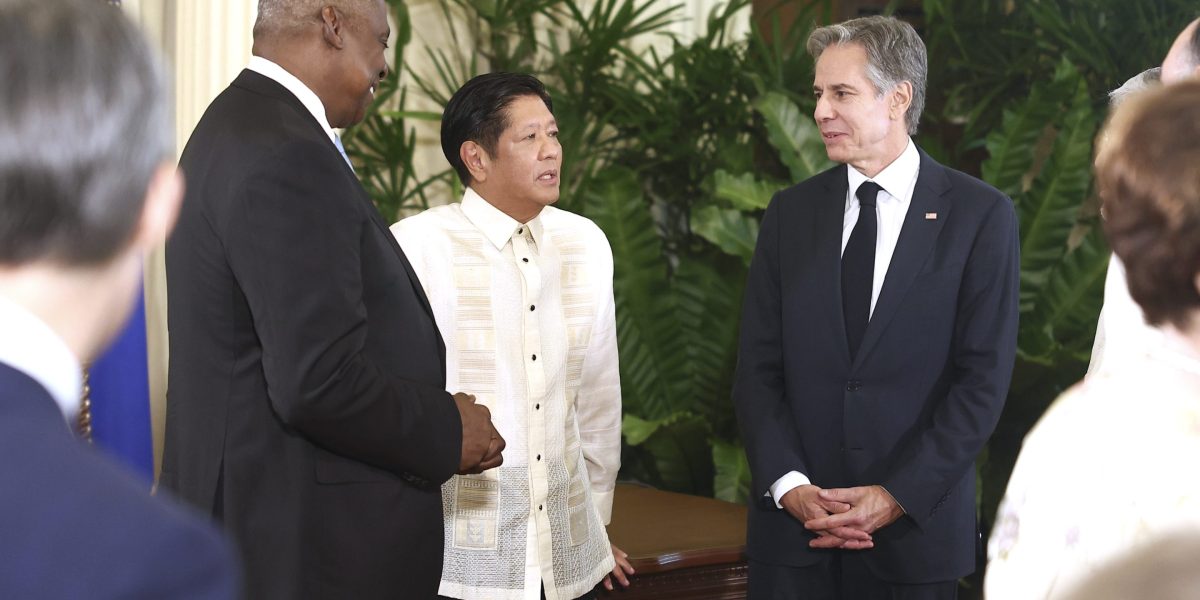

Washington’s top diplomat and defense chief announced $500 million in military funding Tuesday to boost Philippine defenses and progress on a proposed military intelligence-sharing pact as both allies renewed their concerns over China’s continuing aggressive actions in the region.
U.S. Secretary of State Antony Blinken and Defense Secretary Lloyd Austin met with President Ferdinand Marcos Jr., who has fortified Manila’s decades-old treaty alliance with Washington as hostilities between Philippine and Chinese forces flared since last year in the disputed South China Sea.
Marcos hailed “very open” communication lines between Washington and Manila, adding that the two countries’ treaty alliance and key issues in the South China Sea and the Indo-Pacific region “are continuously examined and reexamined so we are agile in terms of our responses.”
Marcos has underscored the need for a U.S. military presence for Asian stability and peace.
After meeting their Philippine counterparts later, Blinken and Austin announced the $500 million military funding to help in an ongoing modernization of the Philippine military and coast guard and boost security collaboration amid shared concerns over China’s assertive actions.
“Both of us share concerns and many other countries in the region share concerns, as well, about some of the actions that the People’s Republic of China has taken, escalatory actions in the South China Sea, the East China Sea,” including “coercive methods,” Blinken said in a joint news conference.
He renewed a warning that the U.S. would help defend the Philippines if Filipino forces, ships and aircraft come under attack in the Pacific, including in the South China Sea.
The U.S. officials also offered condolences over the dozens of deaths wrought by typhoon-worsened monsoon rains in recent weeks and announced an additional $1 million in aid for the victims and to help devastated communities recover.
The visit came the week after the Philippines and reached a temporary arrangement to prevent clashes around the Philippine-occupied Second Thomas Shoal like the violent faceoff between their forces on June 17.
Philippine forces transported food and other supplies and a fresh batch of navy personnel Saturday to Manila’s territorial outpost at the shoal without a confrontation were reported for the first time since last year.
But the Philippines would continue strengthening its territorial defense with the assistance of the U.S. and other friendly military powers and build new security alliances, Philippine Ambassador to the U.S. Jose Manuel Romualdez said.
“The non-confrontational resupply and rotation is purely temporary. The People’s Republic of China will not stop and we are determined just as well,” Romualdez told The Associated Press.
The $500 million in U.S. military financing would include funding for reinforcing the Philippine navy’s capability. About $125 million would be used for constructions and other improvements in parts of Philippine military bases to be occupied by U.S. forces under the 2014 Enhanced Defense Cooperation Agreement, Romualdez said.
With strong support in Congress, U.S. military funding may double next year “depending on our capacity to absorb it,” Romualdez said.
Progress in negotiations on a proposed military intelligence-sharing pact, the General Security of Military Information Agreement was announced by Austin, who said that the accord may be signed later this year.
The agreement, similar to ones Washington has forged with other allied countries, would allow the U.S. to provide high-level intelligence, more sophisticated weapons, including missile systems, and access to satellite and drone surveillance systems to the Philippines with an assurance that such intelligence and details about sophisticated weapons would be closely kept secret in a highly secured manner to prevent leaks, two Philippine officials told the AP, speaking on condition of anonymity because of a lack of authority to discuss the issue publicly.
Philippine efforts to obtain sophisticated weapons from the U.S. military in the past have been hampered by the lack of such an intelligence deal.
In his meeting with Blinken and Austin, Marcos alluded to the intense political divisions in the U.S. ahead of the presidential elections this year.
“I’m a bit surprised considering how interesting your political situation has become back in the States, but I’m glad that you found the time to come and visit with us,” Marcos said.
Meanwhile, Romualdez said that U.S. support to the Philippines would “absolutely” not change regardless of who becomes America’s next president. Numerous countries have expressed concerns about the implications of former President Donald Trump returning to the White House in January after President Joe Biden withdrew and threw his support to Vice President Kamala Harris.
“Both Republicans and Democrats are in full agreement for the Philippines,” he said, adding that both sides have given assurances of continued support to Manila.
Marcos approved last year an expansion of the U.S. military presence in four more Philippine military camps under the 2014 defense agreement, and the largest war drills between Filipino and U.S. forces have been staged under his administration, drawing opposition and alarm from China, which said that increased deployments of American forces would endanger regional peace and security.
The Philippines has responded that it has the right to move to safeguard its territorial interests and national security.















